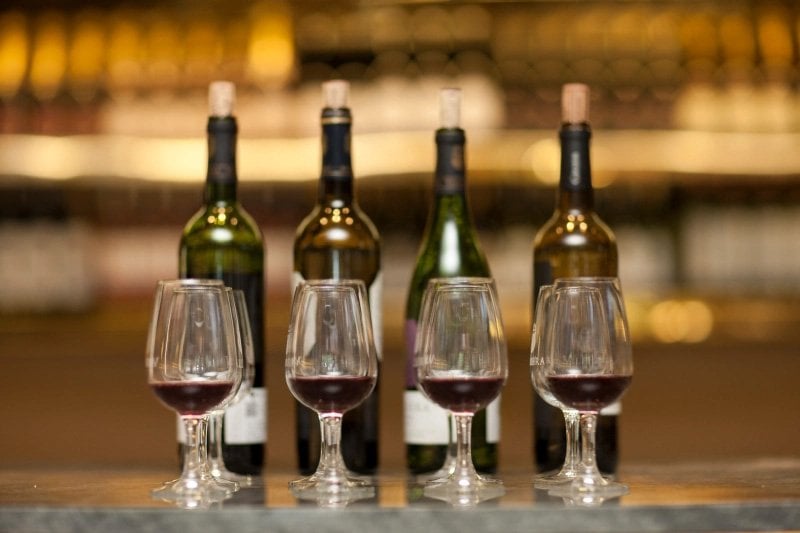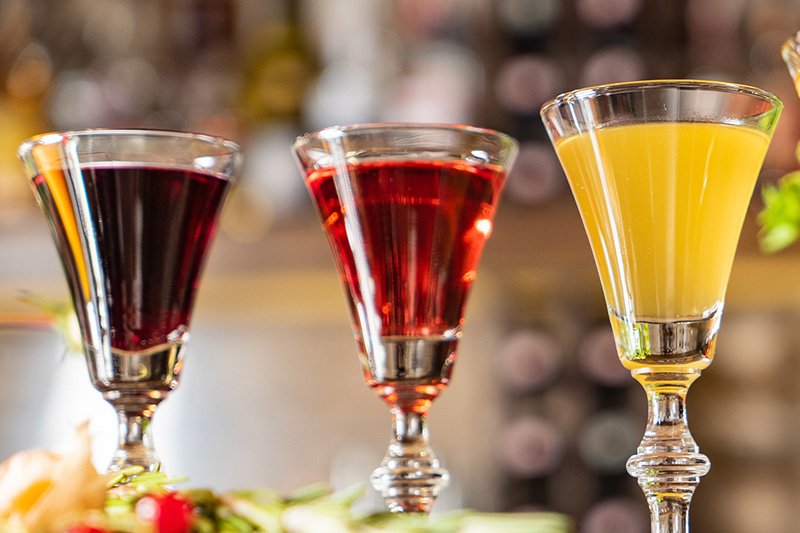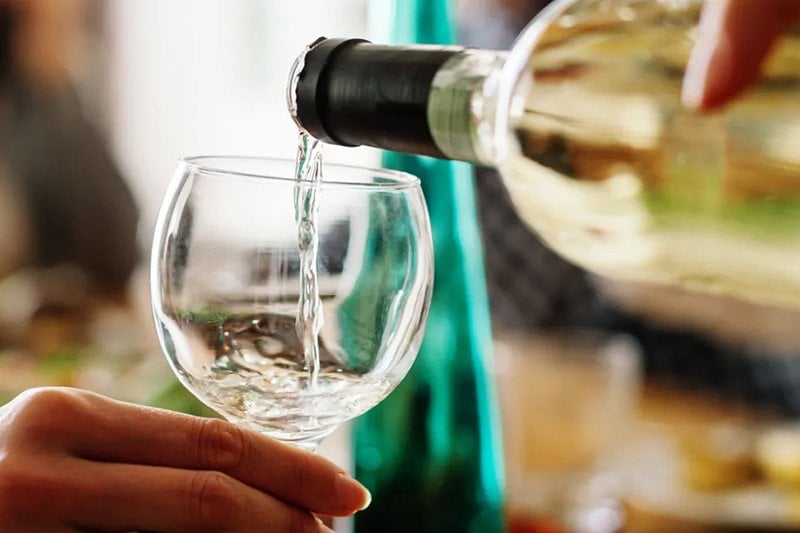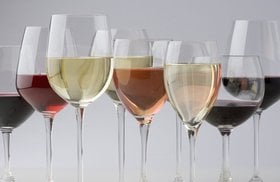How Many Carbs Are in Wine? (By Wine Type, 10 Best Low-Carb Wines)
A glass of sweet red or white wine may pair perfectly with some of your favorite dishes. But the drink may not be ideal if you’re tracking your carb intake.
Why?
Because wines with a high sugar content contain a high amount of carbs.
Now, how many carbs are in a glass of wine?
How do you find the best low carb wine or low sugar wine for your diet — from a diverse range of dry wine, dessert wine, and other wines?
And, should you drink wine on a diet?
This article answers all your queries — from how many carbs are in red wine and white wine, and how to estimate carbs in wine, to the best low carb wines to drink on a diet.
And, if you want to build a collection of the finest wines, we’ll show you how to do that through Vinovest.
Further reading
- Discover the dark, sultry Shiraz wine or go for these light, exotic Roses.
- Explore all about the Best Wine Brands in the world, and the best Red Wine Brands you should know in 2024.
Carbs in Wine: Where Do They Come From?

The net carbs in a wine are a result of the unfermented sugar.
During the grape juice or must fermentation process, the yeast converts the carbohydrates (or, as nutritionists call them, ‘carbohydrate equivalents’) in the wine into alcohol.
If the winemaker stops fermentation before all the carbohydrates are converted, the wine is left with residual sugar (RS).
This residual sugar determines the carbohydrate content of the wine.
Before looking at the carbs in wine, here’s a glimpse at the sugar and alcohol content in a glass of wine (5 ounces or 147 ml):
1. Dry Wine (Red or White)
- Sugar Content: Less than 2 grams
- Alcohol Content (Alcohol by Volume or ABV): 12-13%
2. Off-Dry Wine
- Sugar Content: 3-5 grams
- ABV: 11-12%
3. Sweet Wine (Like Moscato and Sauternes)
- Sugar Content: Up to 10 grams
- ABV: 7-13%
- Sugar Content: As much as 20 grams
- ABV: 8-9%
So, which type of wine (white or red) contains more carbs?
Quick answer: Some red wine styles have more carbs than white wine!
Let’s get into the details.
Carbs in Red Wine

A full-bodied red wine (like a full-bodied dry red wine) has a high amount of carbs. So, if you’re looking for a low carb red wine, check out a dry red wine that’s light to medium-bodied.
Is wine allowed on a keto diet?
Yes! A Pinot Noir, Merlot, or Cabernet Sauvignon wine would work best if you’re on a keto diet.
Meanwhile, Zinfandel and Grenache are considered sweet wines and not the best wines for weight loss. A fortified wine (like Port wine) can have as much as 14 grams of carbs in a glass — not a keto friendly or low carb red wine option either!
(A keto diet is based on ketosis — a metabolic state that primarily utilizes fat to get most of its energy. Keto diet is a moderate protein, high fat, and low carb diet.)
Here’s a quick look at the net carbs in different types of red wine.
Carb Content ( 5 ounces/147 ml) by Red Wine Grape Varietal
- Pinot Noir: 3.4 g
- Merlot: 3.7 g
- Cabernet Sauvignon: 3.8 g
- Syrah: 3.7 g
- Sangiovese: 3.8 g
- Zinfandel: 4.2 g
- Grenache: 4 g
- Malbec: 4.1 g
More red wine nutrition facts:
Red wine also contains:
- Fat:0g
- Sodium:5.9mg
- Fiber: 0g
- Protein:0.1g
Now, how many carbs in white wine?
Carbs in White Wine

If you’re a white wine lover, we have good news!
You can keep your wine keto by sipping dry white wine like Sauvignon Blanc and Brut Champagne. These drinks are light-bodied, low in residual sugar, and pack fewer carbs than dry reds.
Also, dry white wines have a fruity taste. So if you’d like some tasty wine but want to avoid carbs, go for a dry white wine instead.
For instance, Pinot Blanc, Pinot Grigio, and Chardonnay are some of the white wines that typically have low sugar content.
Carb Content in 1 glass (5 Ounces/147ml) by White Wine Type
- Sauvignon Blanc: 3g
- Brut Champagne: 2.8g
- Sparkling White Wine: 1.5g
- Pinot Blanc: 2.8g
- Pinot Grigio/ Pinot Gris: 3g
- Chardonnay: 3.1g
- Dry Riesling: 5.5g
- Chenin Blanc: 4.9g
More white wine nutrition facts:
Your white wine also contains
- Fat 0g
- Sodium 7.4mg
- Fiber 0g
- Protein 0.1g
So, you may ask:
What wine has the least amount of carbs?
The answer is sparkling white wine, followed by Pinot Blanc, Brut Champagne, and Pinot Grigio.
Fun fact: Non alcoholic wine (1 fl oz) contains 0.3g total carbs.
Carbs in Other Alcoholic Drinks
Other alcoholic drinks like whiskey and rum may not have many health benefits. But they pair well with keto diet food due to the zero carb content.
An alcoholic drink with an Alcohol by Volume (ABV) of 13% or less is ideal for a keto diet — as long as it has low levels of residual sugar. So, always check the ABV to choose an alcoholic drink that’s not high-carb.
Let’s look at the net carbs in liquor, beer, liqueurs, and cocktails:
1. Liquor

The fermentation process of hard liquors (vodka, tequila, and rum) reduces the sugar content to almost zero. That’s why these alcoholic beverages are known as zero carb drinks.
But being zero carb doesn’t necessarily make them keto-friendly. That’s because our body burns alcohol instead of fat cells, and frequent alcohol consumption will slow down the weight loss process.
That’s why keto dieters should practice moderation in alcohol consumption.
Fun Fact: You can also consume hard liquors as a mixed drink, like a cocktail.
Here’s a classic vodka drink to try:
Add 4oz of plain seltzer or diet soda to a shot of vodka. Add some lime juice, and enjoy!
2. Beer

It’s no surprise that beer is not a keto-friendly alcoholic beverage. It has high carb content (around 20 grams per 12 ounces or 355 ml serving) and slows down your metabolism.
If you crave a cold beer after a long week at work, opt for a low carb beer.
For instance, a light beer could be a great choice.
Why?
Light beers have low carbs and moderate sugar content and wouldn’t affect your weight loss journey.
Although a light beer has fewer carbs than a regular beer, it’s not an ideal low carb alcohol for a keto diet.
Note that a light beer will also have a small amount of potassium. So, consult your dietician before you consume beer.
3. Liqueurs

If you want to keep your calorie count to a minimum, then avoid liqueurs at all costs. Although you can find liqueurs with moderate alcohol content, they usually have high sugar content. And any alcoholic drink with added sugar is a no-go for a keto diet.
Craving a light beer or a low carb Sangria?
Always keep in mind that alcohol consumption should be kept minimal to maintain ketosis.
4. Cocktails

Cocktails, on the other hand, have juices and syrups with high sugar content — not the best choice for a diet. Artificial fruit juice is high carb and affects blood sugar levels.
Here’s a mixed drink with fewer carbs to satiate your cravings:
Add 4 oz of lime seltzer to a shot of tequila. Add a bit of sugar-free, low carb sweetener, and you’re good to go.
Also, try this tequila drink with grapefruit seltzer or a diet soda.
So, how do you determine the carbohydrate content in your favorite wine?
How to Estimate the Carbs in Wine

The general principle is – the higher the residual sugar, the higher the carbohydrates.
Unfortunately, wine labels don’t provide any nutrition facts - so there is no instant way to know the carb content or the amount of residual sugar in a wine.
But, a wine lover can estimate the residual sugar and carb count of a wine by identifying its ABV and style. We’ll tell you how:
1. ABV
Alcohol is the result of the fermentation of sugar by the yeast. The more sugar the yeast eats, the higher the ABV will be. So, wines with high ABV levels usually have low sugar levels.
Take the example of German Riesling. The dry Riesling wine has 10%-11% ABV and contains 5-6 grams of carbs. On the other hand, a late harvest Riesling wine has 8-9% ABV and up to 20 grams of carbohydrates.
2. Wine Styles
The style of wine can be used as an indicator of residual sugar in the wine.
- Bone dry wines have less than 1g of sugar per glass - they’re the best for a ketogenic diet.
- Dry wine contains 1 gram (2 at the most) of residual sugar per glass.
- Sweet wine can have 3 to 5 grams of sugar per glass of wine.
- Dessert wine can go to 30 to 40 grams RS per glass (5 ounce serving or 147ml.)
The RS levels in sparkling wine are as follows:
- Brut Nature wines are one of the driest wines. There’s only 0 to 3 grams of sugar in a bottle of wine.
- Extra Brut contains 4 to 6g RS per liter. If you want a keto wine to go perfectly with your low carb diet, then an Extra Brut wine is a go-to choice.
- Brut wines have 7-12g RS per liter - good low carb alcohol for a keto diet.
- Extra dry wines contain 12-17g RS per liter.
- Dry (Sec) sparkling wines can go up to 17-32g per liter.
- Demi-Sec (Off-Dry) and Doux (sweet) sparkling wines are considered sweeter winesand pack maximum carbs. Demi-sec wines have 32-50g residual sugar per liter, while sugar in doux sparkling wines can go even higher.
Can You Drink Wine on a Diet?

Yes, you can drink wine even if you’re on a low carb diet.
But, keep these tips in mind:
- Low-quality wines in grocery stores are not made from the best quality grapes. Winemakers add sugar to make it taste more fruity - even when it says ‘Dry’.
- Alcohol consumption will affect your diet - no matter how low the alcohol content. Too much wine consumption will eventually slow down your weight loss.
- A standard drink has a serving size of 5 ounces (147ml). Exceeding it will also increase your carb count.
- Dessert wines or sweet wines are high carb and must be avoided at all cost.
But this doesn’t mean you cannot enjoy a drink occasionally — the key is moderate alcohol consumption and being more conscious of your calorie count.
What Wines Can You Consume on a Diet?

A lower carb dry wine can be enjoyed occasionally.
Red wines like Merlot, Cabernet Sauvignon, and Pinot Noir are perfect for the keto and Paleo diet because they are low carb and have moderate wine calories.
Some dry white wines for a ketogenic diet include Champagne (Brut or Extra Brut), Pinot Blanc, and Pinot Grigio.
You can also go for low carb organic wines. When producing these drinks, the winemakers use traditional winemaking methods with no added sugar, preservatives, or sulfites that reduce the amount of carbs in wine.
Alternatively, try dry farm wines.
Dry farm wines result from dry farming (unlike your usual wines) — a method of growing grapes without extra irrigation, no matter the weather conditions. The grapes will have a lower concentration of sugar and produce drier wine.
Wines to Avoid on a Diet

Keto diet requires a proper meal plan with low carb foods and beverages. Some wines with high sugar content that you should avoid are:
- Dessert wine
- Late harvest wine
- Fortified wine
- Spatlese
- Auslese
- Ice Wine (Eiswein)
- Doux
- Demi-sec
- Semi-sec
- Dolce
Keeping Blood Sugar Levels Under Control While Drinking Alcohol on a Diabetic Diet

If you are on a diabetic diet, maintain blood sugar levels by measuring your carb intake and having a low carb diet.
Here are some helpful tips on alcohol consumption on a diet.
- It's not recommended to drink alcohol on an empty stomach.
- Do not count the carbohydrate in an alcoholic beverage as the carbohydrate in your meal plan.
- Stay hydrated by drinking lots of water.
- Go for a low-calorie drink — aka no sweet wine to keep your carbohydrate intake and your blood sugar in check.
Now every calorie counts, and that’s why choosing the right alcoholic beverage with your keto diet is important.
Is a Low-Carb Wine the Same Thing as A Low-Calorie Wine?

No!
Low-carb wines have reduced carbohydrate content and low sugar levels.
Meanwhile, low-calorie wines have a lower alcohol content or reduced sugar. But the majority of calories in these drinks come from the alcohol content and not sugar.
What does all this mean?
Even if a wine is lower in carbohydrates (or sugar), it could still be high in calories if it has a higher alcohol content.
Now, what are the low carb wines that you should get hold of?
10 Best Low Carb Wines to Buy in 2024
Whether you choose a dry red wine or a Pinot Gris white wine, you need to focus on the wine calories.
Here are some low carb, keto friendly wine options you can buy in 2024:
A. Brut Champagne

Champagne Brut is a dry Champagne that packs a low amount of residual sugar — only about 2.8 grams of carbohydrates in a glass of wine. The low wine calorie levels maintain ketosis, and net carbs remain low — perfect for a ketogenic diet.
These low carb Brut Champagne wine bottles would be a great choice:
- 2002 Louis Roederer Cristal 'Gold Medalion' Orfevres Limited Edition Brut Millesime, Champagne, France ($4,736): This sparkling wine is a blend of Pinot Noir and Chardonnay grape varieties. It has fewer calories than most wines and is a perfect alcoholic beverage for a ketogenic diet.
It has a silky texture and offers the aromas of cocoa, finely roasted hazelnuts, and candied citrus fruit. On the palate, it offers the flavors of red fruits, white chocolate, and caramel.
- NV De Barfontarc Brut Tradition, Champagne, France ($36): Here’s a beautiful, light gold Champagne with a white fruit nose coupled with dried herbal notes. The palate is fresh, soft, and fruit-forward and offers ripe apple and pear flavors.
Another Champagne you can try is Cava from Spain. Cava is a sparkling wine made from a diverse range of grapes with various flavors. It comes in two styles — white and rose Cava wines.
B. Dry White Wine

Dry white wines are best suited for a diabetic diet. They have less than 4 grams of carbs per serving, which keeps your carb intake low.
- 2013 Screaming Eagle Sauvignon Blanc, Oakville, USA ($6,948): A dry and light wine, the 2013 Screaming Eagle Sauvignon Blanc has a dominant grapefruit taste. You will also get hints of tropical fruit flavors that add sweetness to the wine — a great choice for a low carb wine.
- 2020 Cloudy Bay Te Koko Sauvignon Blanc, Marlborough, New Zealand ($62): This drink offers exotic aromas of grapefruit, guava, passionfruit, honey, and vanilla. On the palate, it displays vibrant acidity, a smooth texture, and passionfruit flavors with honey notes.
- 2005 Moulin Touchais Coteaux du Layon, Loire, France ($46): This wine boasts crisp acidity and yellow-fruit flavors with creamed peach, mango, guava, and honey notes. On the nose, it offers aromas of chamomile and salted butter.
C. Dry Red Wine

Red wines are often full-bodied. So while choosing a red wine, make sure to get a light to medium-bodied wine.
Try these:
- 2004 Domaine Leroy Bourgogne Rouge, Burgundy, France ($4,681): Red wines from Burgundy are usually not considered the best low carb drinks. But this rare light-bodied dry red wine packs low carbs and rich dark fruit flavors.
- 2015 Castello di Volpaia Il Puro Casanova, Chianti Classico Gran Selezione DOCG, Italy ($155): This is a Sangiovese grape wine from Chianti DOCG. Unlike Pinot Noir, this red wine has earthy notes of tobacco, soil, and forest. Notes of fresh red fruits, including strawberry and raspberry, give it a sugary taste.
- 2016 Emeritus Vineyards Hallberg Ranch Pinot Noir, Russian River Valley, USA ($48): This elegant dry farm wine is made with Pinot Noir grapes and has the aromas of dark cherries, violets, and blueberry. The palate is smooth with fine tannins — a perfect keto friendly wine!
D. Dry Rosé Wine

Give these two dry low carb Rosé wine bottles a shot:
- 2019 Muse de Miraval Cotes de Provence Rose, France ($136): A crisp and dry wine from the Provence region of France, this Rosé wine is made from Grenache, Syrah and Mourvedre grapes.
The aroma of juicy peach and strawberry ice cream notes comes through on the nose. And the palate has a creamy, rich texture with delicious freshness.
- 2017 Chateau d'Esclans Cotes de Provence Garrus Rose, France ($111): Dominant flavors of red fruits and citrus characterize this rich and complex wine. Light on the palate, this Rosé wine from Provence is one of the best wines for a low carb diet.
Now, all these low carb wines are good for your diet plan.
While you’re looking for these bottles, why not build a collection of investment-grade bottles as well? One that’ll reap you benefits in the long-term!
But how do you get hold of a fine bottle or two?
Your best option would be to entrust a wine investment company like Vinovest.
Invest in the Finest Wine Bottles Through Vinovest

Vinovest is an online wine investment company that helps you invest in some of the finest wines from across the globe.
Vinovest also stores them in climate-controlled warehouses, authenticates, and even sells them when the time is right. You can also have them delivered to you if that’s what you want.
And, if it’s a low-carb wine, nothing like it, right?
How Does it Work?
Investing with Vinovest is quick and simple with these four steps:
- Sign up on the Vinovest website.
- Share your risk appetite and investment preferences.
- Fund your account ($1,000 or more.)
- Start building a wine portfolio!
Consider these compelling reasons to give Vinovest a try:
- Easy Buying and Selling: Vinovest’s AI-driven platform makes it easy to buy and sell wine with just a few clicks.
- Best Prices: Vinovest buys wine directly from wineries, wine merchants, and global wine exchanges at the best wholesale prices.
- Optimal Storage: Vinovest stores your wine in temperature-controlled bonded warehouses with optimal humidity, vibration, and light storage conditions.
- Hassle-free Delivery: If you decide to open your bottle for a special occasion or sell it to a suitable buyer, Vinovest will arrange the delivery - hassle-free!
- Ownership: You have complete ownership of all your wine bottles.
Being on a low carb diet (Paleo diet or a Keto diet) doesn’t mean staying away from simple wine pleasures. You can always enjoy a glass of a rich red wine or low carb beer as long as you monitor your overall calorie intake.
To invest in the highest quality, authentic wine bottles in the world, sign up with Vinovest right away!



